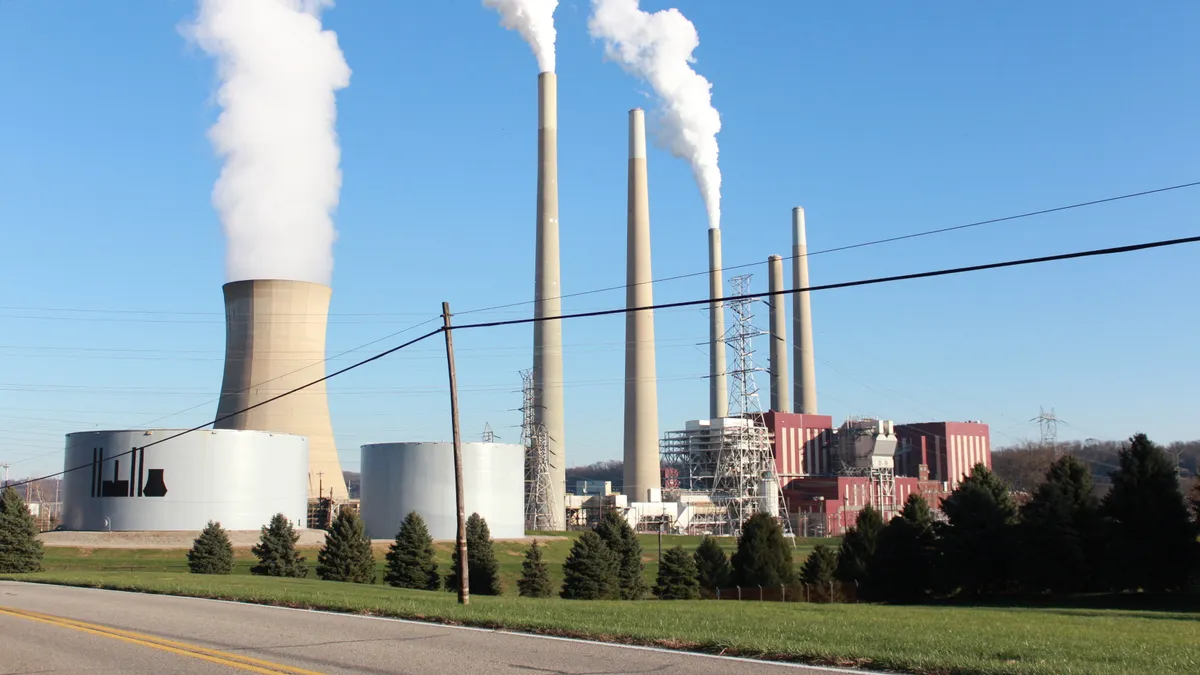Dive Brief:
-
Competitive energy supplier Vistra on Tuesday announced it would retire 6,800 MW of coal by 2027, blaming in part its grid operator's "irreparably dysfunctional" market.
-
The company owns seven coal-fired power plants across the Midwest, mostly within the territory of the Midcontinent Independent System Operator (MISO), and would retire the majority of its plants through 2025-2027 "or sooner should economic or other conditions dictate," the company said in a statement. Alongside those retirements, Vistra plans to reach net-zero emissions by mid-century and add nearly 1,000 MW of solar, plus one energy storage project by the end of 2022.
- Company officials blamed state subsidies, declining gas prices, an overbuild of resources and the "systemic failure of the MISO capacity market to provide Illinois-based power plants with adequate revenues" for its coal fleet. The announcement marks one of the largest coal fleet retirements in U.S. history, according to the Sierra Club.
Dive Insight:
More competitive prices for wind, solar and gas, along with an increase in state-level efforts to eliminate coal-fired power have exacerbated the pressure on coal, rendering it largely uncompetitive compared to other market resources. Merchant coal plants are uniquely vulnerable to coal's failing economics within competitive markets, because unlike vertically integrated rate-regulated utilities, competitive energy providers are unable to recover any losses associated with plants through their ratebase.
Vistra blames the economic decline of its coal fleet on a number of factors, including state subsidies for renewable energy and nuclear power, existing and future environmental regulations and "regulatory and political headwinds," said Vistra spokesperson Meranda Cohn in an email. These already unfavorable conditions in MISO, along with the PJM Interconnection, are further under threat from Illinois' and New Jersey's threats to leave the wholesale markets through a Fixed Resource Requirement (FRR), or some other option, she said.
MISO declined to comment.
Zero-emission credits in Illinois have been blamed for similar price distortions in the PJM Interconnection, which shares the state with MISO. Those complaints wrought by competitive generator Calpine ultimately led to the creation of the Minimum Offer Price Rule, which raises the bid floor for subsidized resources selling into the PJM market. And that rule is the reason behind New Jersey and Illinois' threats to leave PJM, which Cohn said would put "pressure on our PJM plants."
But though the company blames state policies in part for failing economics, Vistra's CEO earlier this year noted the pressure was almost entirely markets-based.
"The one key about coal plants is that they're closing naturally because natural gas prices are low, which then turns power prices low," Curt Morgan, president and CEO said in a February interview. "Even though the States are anti coal, what is interesting is that's not why coal plants are shutting down."
| Plant | State/Market | Capacity | Retirement Date* |
|---|---|---|---|
| Edwards Power Plant | Illinois (MISO) | 585 MW | 2022 (previously announced) |
| Baldwin Power Plant | Illinois (MISO) | 1,185 MW | 2025 |
| Joppa Power Plant | Illinois (MISO) | 1,002 MW (plus 239 MW gas) | 2025 |
| Kincaid Power Plant | Illinois (PJM) | 1,108 MW | 2027 |
| Miami Fort Power Plant | Ohio (PJM) | 1,020 MW | 2027 |
| Newton Power Plant | Illinois (MISO) | 615 MW | 2027 |
| Zimmer Power Plant | Ohio (PJM) | 1,300 MW | 2027 |
* Retirement dates will be shifted "sooner should economic or other conditions dictate."
The company made an effort to save the facilities by lowering plants' minimum operating levels and increasing its ability to turn the plants off and on more efficiently.
"Unfortunately, even with these efforts, the plants remain uneconomic," Cohn said.
Rate-regulated utilities often cite the inefficiency of turning plants on and off fully as part of their reasoning for keeping plants running even when they aren't competitive in the wholesale markets, and others have cited coal plants' lack of flexibility for their failure to compete in markets at large.
Vistra also plans to build out its renewable energy portfolio, adding 928 MW of solar over the next two years, totaling six projects plus one 10 MW addition to an existing project. The projects represent a capital investment of about $850 million, and are all located within the "attractive" Electric Reliability Council of Texas market.
| Project Name | Capacity |
|---|---|
| Andrews Solar Facility | 100 MW |
| Brightside Solar Facility | 50 MW |
| Emerald Grove Solar Facility | 108 MW |
| Upton 2 Solar and Energy Storage Facility – Phase III | 10 MW addition (will make total project capacity 190 MW) |
| DeCordova Energy Storage Facility | 260 MW/260 MWh |
| Forest Grove Solar Facility | 200 MW |
| Oak Hill Solar Facility | 200 MW |
The company's accelerated coal plant retirements and renewable energy additions bump its emissions reduction targets to 60% below 2010 levels by 2030 and net-zero carbon emissions by 2050.















